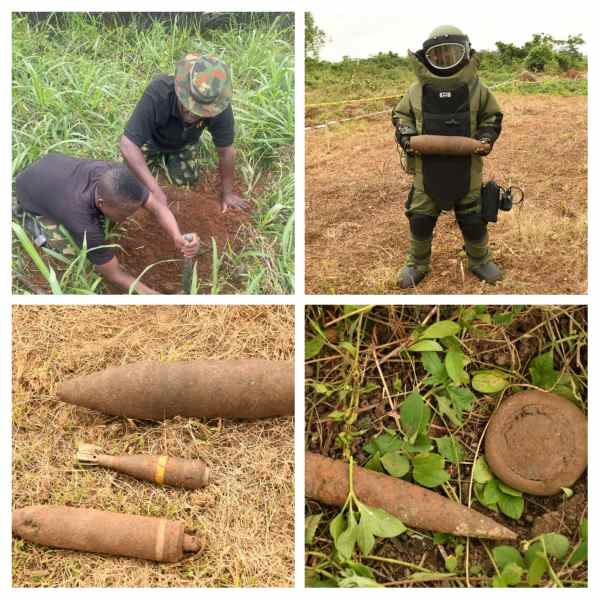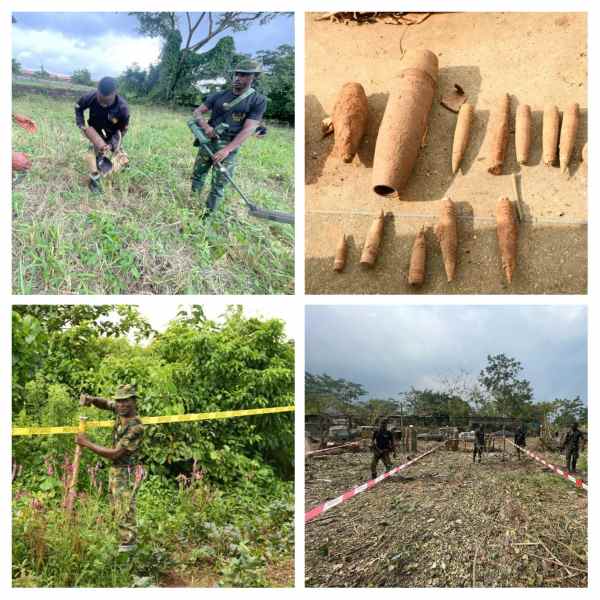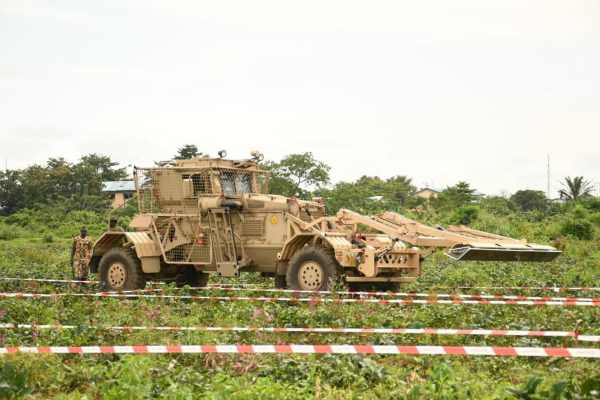
By Okosun Dennis

Two days after “Exercise Clean Sweep” began to disinfect the epicentre of the 2002 bomb blast at the Ikeja Cantonment, 93 unexploded ordnance have been recovered of various calibres and descriptions.
In his maiden brief of the press on Thursday at the Command and Media Centre, Ikeja Cantonment, the Director at the Directorate of Explosives Search and Disposal, Nigerian Army Engineers (NAE) and who is also the Coordinator of “EXERCISE CLEAN SWEEP”, Colonel Abdulrazaq Olapeju Kazeem, gave updates on the progress made so far on clearance plan, safety measures and other itineraries with a view to meeting the timeline set to achieve total decontamination of the site.
The Chief of Army Staff (COAS), Lt Gen Taoreed Lagbaja had on Tuesday at the epicentre, flagged off the exercise designed to mop up remnants of unexploded Ordnances discovered recently.
Colonel Kazeem noted that the recovery operation was going on under the strictest safety measures to mitigate unforeseen circumstances.
As such, they have carefully deployed sophisticated equipment, bomb experts equipped with bomb suits and ballistic helmets, fire fighting equipment, and medical personnel as well as trained auxiliary personnel for seamless disinfection.

He revealed that NAE was saddled with the responsibility of raising an Explosive Ordnance Disposal team to recover Unexploded Explosive Ordnance (UXOs) at the site of the 2002 Bomb Blast at Ikeja Military Cantonment.
“Despite past clearance and disposal exercises at the site, there have been several reports of the discovery of remnants of UXOs within and around the vicinity of the bomb blast much to the detriment of safety and security of the inhabitants of the Cantonment and environment.
He averred that after conducting reconnaissance, they came up with a plan for the clearance exercise, involving multi-agency efforts like the Nigerian Army Engineers, (NAE), Nigerian Army Ordnance Corps (NAOC), and 81 Division.
Other Civilian stakeholders involved included the Lagos and Ogun States Governments, Federal Fire Service (FFS), Federal Road Safety Commission (FRSC) as well as Lagos and Ogun States Emergency Management Agencies.
Responding to a question on the duration of recovered unexploded ordnances will be kept at the epicentre before being moved to the Military Range, Ajilete, Ogun State where they would be detonated under controlled measures, Col Kazeem further explained that evacuation is strictly based on reaching explosive limits.

“The moment we reach maximum limits of explosives within our holding area, such ordinances will be moved to the range. If we get to the explosive limits today, I will move to the range today. We would not exceed a kilogramme above the explosive limits because it is measured in kilogramme. We wouldn’t cross that line. At 93, we have not yet reached the limits,” he reiterated.
However, he continued, “There are some unexploded ordnances that are unstable but based on our expert assessment, and if we have anyone like that; in order not to put the lives of Nigerians at risk, with adequate safety measures, we shall be able to detonate such but it’s going to be extremely a rear case. At the moment, we have not seen such and we hope not to see any.”
On why inhabitants of the barracks were allowed to carry out farming activities close to the epicentre considering the volatility of the ordnances, Col Kazeem noted that from the outset after the blast, precautionary measures were taken to ensure inhabitants were kept out of the epicentre.
“There were measures and warnings by the Nigerian Army to dissuade inhabitants from farming in contaminated areas. Soldiers were put there 24 hours to keep human activities away. You can see the place is well-vegetated. Where they farm (Amber area) are not sensitive.”
On his part, the Safety Officer, Lt Col Oluseyi Oladapo Bamikole said they have put necessary measures in place for the safety of personnel as they have made adequate equipment available including demarcations and trained personnel to identify UXO before recovery from the site.
In addition, there are restrictions on unauthorized access to the site and during evacuation of recovered ordnance, vehicles will move at snail speed to avoid friction or any eventuality.

Earlier, the Coordinator gave a further assessment of what they have put in place in phases to have a seamless Exercise.
Among those phased arrangements are the Mobilisation which involves reconnaissance and planning and vegetation Clearance in all the Sectors using manual and herbicide methods.
Others are Search/Recovery of UXO and Demobilisation comprising the General Site Inspection at the completion of the search/recovery task to check for areas that might have been overlooked as well as leftover UXOs, munition parts, and scrap metals.
While soliciting the cooperation of the media to assist in educating and enlightening members of the public about the entire operations, said they would serve as the link between the Nigerian Army and the public.
It would be recalled that the unfortunate incident of the Ikeja Cantonment Bomb Blast took place on the 28th of January 2002, killing hundreds of people outside the epicentre and destroying several troops’ accommodations and properties within the barracks.



